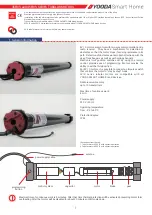
-2-
1. Propeller
Standard spec is Mejzlik D24” x P10” which brings approx. 6200rpm.
Depending on the airframe, please adopt the adequate size in the range
of 5500~6500rpm from reliable products generally on the market.
(Carbon prop is recommended)
Since a large-diameter prop is used, please maintain sufficient balance.
Since an imbalanced prop is vibratory and dangerous with lowered
performance, please maintain balance with a balancer. Moreover, a
cracked prop is dangerous. Make sure to check any time and replace it
with a new one if itʼs cracked.
*Tighten up the prop nut once in about every 10 flights. Especially a
wooden prop tends to compressed so take care of its looseness.
2. Fuel
The fuel is mixture of commercial regular gasoline and reliable oil for
2-stroke. (Unleaded high-octane gasoline is not
necessarily required for SAITO engine.)
[Example of oil]
・ POWER LUBE (KLOTZ ORIGINAL TECHNIPLATE)
・ KLOTZ GS RC model LUBE
・ CASTROL POWER1 TTS Racing, etc.
For the mixture ratio, please be sure to use “gasoline : oil =15~20 : 1” or richer by volume ratio.
(ex. 1000ml of gasoline should be mixed with more than 50ml of oil ).
Any damage caused by the fuel used, in which the oil ratio is lower than 20:1 ratio, is not warranted.
Since gasoline is dangerous material, be careful of its storage, use, and transport enough. (The evaporative emission and
exhaust smoke of gasoline have a harmful effect on a human body. Also, if gasoline is leaked, there is danger of fire etc.)
Please note that we take no responsibility for accidents, health damages, etc which occur during storage, use and transport of
gasoline.
3. Fuel Filter and fuel pump
Since commercial gasoline has many impurities, please be sure to use a reliable filter
for the admission port of the gasoline-proof fuel pump (Fig.3), and in the fuel tank as
well (Fig.4). Without using a filter, the performance of the carburetor is not delivered,
resulting in failures.
Using optional part “Filter with weight” is highly recommended.
Firing order
Prop direction
Firing order
1
-
3
-
2
Fig.4
Fuel tank
Mount spacer
Hollow out referring to
the cutting sheet
View from the rear
Fig.2
#1
#2
#3
Gasoline-proof tube
(Option)
(Option)
Filter with weight
Gasoline-proof
Pump
Fig.3
4. Fuel tank and piping
Use the gasoline proof tank which has adequate capacity (Approx. “Fuel consumption x Flight du 100~200cc). Please be
sure to use a filter with weight. To avoid entrain any impurities to the carb, piping with “Fuel feeding pipe” and “Air inhalation
pipe” (Fig.5) is recommended.
*Please be sure to use “gasoline-proof” products for the tank, lid rubber, piping, and tubing. Some of the products for glow fuel
canʼt be used for gasoline.
*Please check carefully if thereʼre any crack on the piping, tubing, connection, and tank. All of the connection parts should be
bound by thin Nylon strap or wire to avoid fuel leakage or air induction to the fuel line. (If there are any leakages, the perfor-
mance of the engine decreases dramatically.)
*The carburetor has a pump but its pumping pressure is not so strong. So place the tank close to the engine as much as
possible. And set the fuel level slightly lower than the center of the carb.
*When provide “Air inhalation pipe” as Fig.5, arranging the tube above the fuel level is the effective way of fuel leakage preven-
tion.
*The carburetor comes out from the back of the firewall. Sometimes fuel get flown back from carburetor and may spatter inside
the firewall. For that case, make sure to cover the batteries, R/C equipments and all the foam members with gasoline-proof
material.
Fuel level
above
Fuel level
to Outside of
the fuselage
Fig.5
Air inhalation pipe
Fire wall
to Carb nipple
Fuel feeding pipe
Air inhalation
pipe
Rubber cap for
gasoline-resistant
Gasoline-proof tube
Filter with weight
Center of fuel tank
Close as possible


























